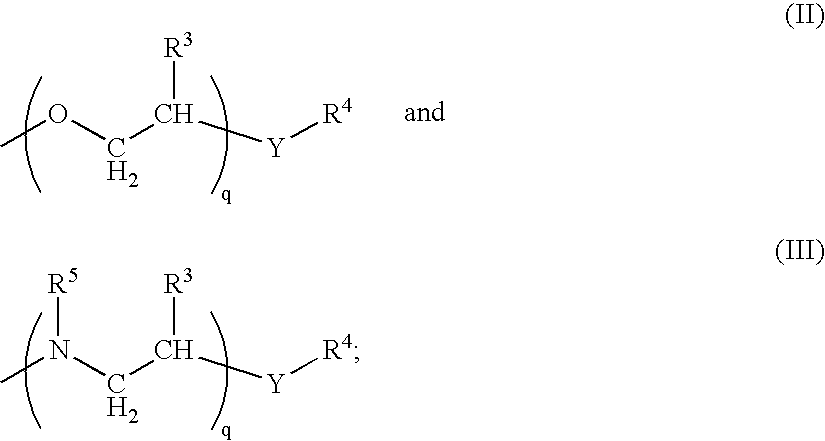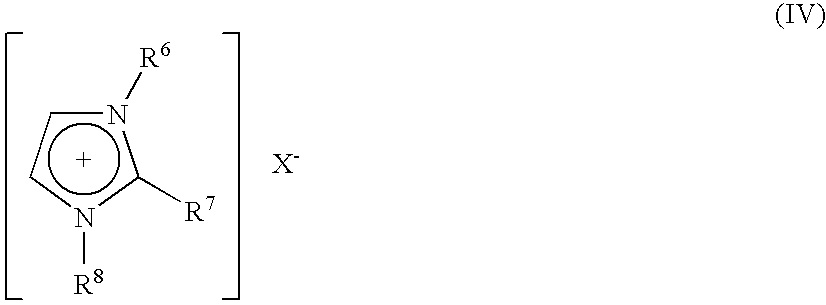Polymer nanocomposites and methods for their preparation
a polymer and polycarbonate technology, applied in the field of polymer nanocomposites, can solve the problems of difficult process of nanocomposites comprising polyorganosiloxane-polycarbonate copolymers and inorganic clays (or silicates), and achieve the effect of low weigh
- Summary
- Abstract
- Description
- Claims
- Application Information
AI Technical Summary
Benefits of technology
Problems solved by technology
Method used
Image
Examples
##ic example 1
Prophetic Example 1
[0055] This example describes the preparation of a low molecular weight hydroxy-endcapped bisphenol A homopolycarbonate having a weight average molecular weight of about 8,000. The procedure is also described as a part of Example 2 in Column 6, lines 27-42 of U.S. Patent No. 6,143,859, which is incorporated herein by reference.
[0056] A 1-liter glass melt polymerization reactor is passivated by acid washing, rinsing with deionized water and dried overnight at about 70.° C. The reactor is then charged with 130.4 grams (608.6 millimoles) of diphenyl carbonate and 120 grams (525.6 millimoles) of bisphenol A. A solid nickel stirrer is suspended in the mixture, and the reactor is purged with nitrogen and heated to about 180° C., whereupon the reaction mixture melts. Upon complete melting, it is allowed to equilibrate for 5-10 minutes, with stirring. Then, with stirring, 600 microliters of a 0.221 Molar aqueous tetramethylammonium maleate solution and 500 microliters of...
example 2
[0057] This Example describes the general procedures used for preparing the polymer nanocomposite molding compositions using the low molecular weight hydroxy-end capped bisphenol A homopolycarbonate having a weight average molecular weight of about 8,000 daltons, prepared as described in Prophetic Example 1.
[0058] In one method for preparing the polymer nanocomposites, hereinafter referred to as method “X” in Table 1, the necessary individual components listed in Table 1 were weighed out separately and then blended in a Banbury mixer. Alternatively, the individual components were mixed in a solvent, such as toluene or dichloromethane; stirred under high speed stirring and under refluxing solvent, and the solvent removed by distillation and / or evaporation under reduced pressure to afford the dry polymer nanocomposite. The resulting material was then extruded using an extruder.
[0059] In another method, hereinafter referred to as “Y”, the swelling agent (300 grams) was first dissolve...
PUM
| Property | Measurement | Unit |
|---|---|---|
| weight average molecular weight | aaaaa | aaaaa |
| weight average molecular weight | aaaaa | aaaaa |
| ductile failure temperature | aaaaa | aaaaa |
Abstract
Description
Claims
Application Information
 Login to View More
Login to View More - R&D
- Intellectual Property
- Life Sciences
- Materials
- Tech Scout
- Unparalleled Data Quality
- Higher Quality Content
- 60% Fewer Hallucinations
Browse by: Latest US Patents, China's latest patents, Technical Efficacy Thesaurus, Application Domain, Technology Topic, Popular Technical Reports.
© 2025 PatSnap. All rights reserved.Legal|Privacy policy|Modern Slavery Act Transparency Statement|Sitemap|About US| Contact US: help@patsnap.com



